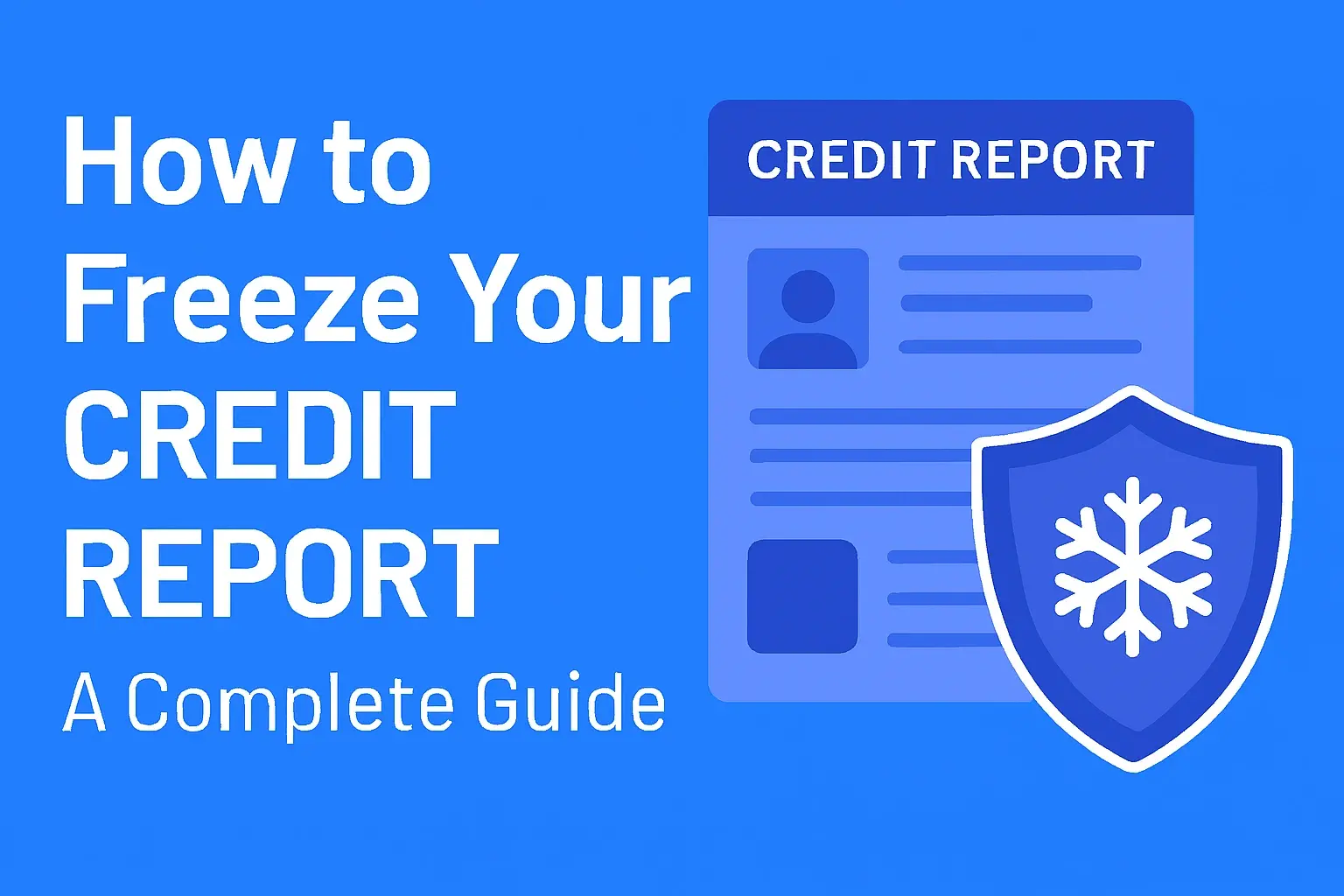-
Posted on: 23 Apr 2025

-
Understanding your credit report is fundamental to financial health. This comprehensive guide breaks down the credit report definition, its components, how it's used, and how to leverage this crucial document for your financial advantage in 2025.
What is a Credit Report?
A credit report is a detailed record of your credit history, compiled by credit bureaus. It outlines how you've managed debt, including loans, credit cards, and mortgages, and provides lenders with a comprehensive view of your financial behavior. In essence, it's your financial resume, showcasing your reliability in repaying borrowed money.
Key Components of a Credit Report
Your credit report is a multifaceted document, containing various types of information that paint a complete picture of your financial past and present. Understanding these components is the first step to effectively managing your credit.
1. Personal Information
This section includes your identifying details. It's crucial to ensure this information is accurate, as discrepancies can sometimes lead to confusion or even identity theft concerns. Information typically found here includes:
- Full Name
- Social Security Number (often partially masked for security)
- Date of Birth
- Current and Previous Addresses (usually for the last 7-10 years)
- Employment Information (current and past employers, job titles, and dates of employment)
While this section seems straightforward, errors can occur. For example, a misspelled name or an incorrect address from years ago could, in rare cases, be linked to someone else's credit history. Always review this section carefully.
2. Credit Accounts
This is the core of your credit report, detailing every credit account you've ever opened. For each account, you'll find:
- Type of Account: (e.g., credit card, auto loan, mortgage, student loan, personal loan)
- Creditor Name: The company that issued the credit.
- Account Number: Usually partially masked for security.
- Date Opened: When the account was established.
- Credit Limit or Loan Amount: The maximum amount you can borrow on a credit card or the original amount of a loan.
- Current Balance: The amount you currently owe.
- Payment History: This is perhaps the most critical part, showing whether payments were made on time, late (and by how many days), or missed entirely.
- Status: Whether the account is open, closed, paid off, or in collections.
- Date of Last Activity: The last time the account was used or updated.
The payment history is a primary driver of your credit score. Consistent on-time payments are essential for a good credit report.
3. Public Records
This section contains information from public sources that can significantly impact your creditworthiness. These are generally negative items, and their presence can make it harder to obtain credit.
- Bankruptcies: Records of Chapter 7, 11, or 13 bankruptcies. These remain on your report for 7 to 10 years, depending on the type.
- Liens: Legal claims against your property, often for unpaid taxes (tax liens) or judgments. These can remain for 7 years or until paid.
- Judgments: Court rulings against you, typically for debts owed. These can remain for 7 years or until paid.
- Foreclosures: When a lender repossesses your home due to non-payment.
These items are serious and have a substantial negative effect on your credit profile.
4. Inquiries
Every time you apply for credit, the lender typically pulls your credit report. This action is recorded as an inquiry.
- Hard Inquiries: Occur when you apply for new credit (e.g., a credit card, loan, or mortgage). These can slightly lower your credit score because they suggest you are seeking new debt. Multiple hard inquiries in a short period can be a red flag.
- Soft Inquiries: Occur when you check your own credit, a potential employer checks your credit with your permission, or a lender pre-approves you for an offer. These do not affect your credit score.
It's important to distinguish between these two types of inquiries.
How Credit Reports Are Generated
The creation of a credit report is a systematic process involving data collection, aggregation, and reporting. Understanding this process helps demystify how your financial actions translate into a formal record.
1. Data Collection from Furnishers
The primary source of information for credit reports is "furnishers." These are entities that extend credit to consumers and include:
- Banks and credit unions
- Credit card companies
- Mortgage lenders
- Auto loan providers
- Student loan servicers
- Retailers offering store credit
- Collection agencies
These furnishers report account information to the major credit bureaus on a regular basis, typically monthly. This data includes details about your payment history, balances, credit limits, and account status.
2. Aggregation by Credit Bureaus
The three major credit bureaus in the United States—Equifax, Experian, and TransUnion—collect this vast amount of data from thousands of furnishers nationwide. Each bureau maintains its own database, which means your credit report can differ slightly from one bureau to another.
They use sophisticated systems to organize and categorize this information, linking it to your unique identity (primarily through your Social Security number). The goal is to create a comprehensive and accurate profile for each consumer.
3. Reporting and Updates
Once collected and processed, this data forms your credit report. The information is dynamic and is updated regularly as furnishers report new activity. For example, a late payment reported by your credit card company will appear on your report shortly after the reporting period closes.
The Fair Credit Reporting Act (FCRA) mandates that furnishers report accurate information and investigate disputes. This regulatory framework ensures a degree of integrity in the data collection process.
The Role of Credit Bureaus
Credit bureaus, also known as credit reporting agencies (CRAs), are central to the credit reporting system. They act as intermediaries, collecting financial data from various sources and compiling it into credit reports for consumers and businesses.
Major Credit Bureaus
In the United States, the three primary national credit bureaus are:
- Equifax: One of the oldest and largest CRAs.
- Experian: Another major player with a global presence.
- TransUnion: The third of the "big three," known for its extensive data.
These bureaus are responsible for collecting, maintaining, and disseminating credit information. They do not lend money or make credit decisions; they merely provide the data that lenders and others use to make those decisions.
Functions of Credit Bureaus
- Data Collection: Gathering credit-related information from lenders, creditors, and public records.
- Report Generation: Compiling this data into detailed credit reports for individual consumers.
- Credit Scoring: Often partnering with or developing scoring models (like FICO and VantageScore) to provide a numerical representation of creditworthiness.
- Dispute Resolution: Investigating consumer disputes regarding inaccuracies on their credit reports.
- Providing Access: Offering consumers access to their credit reports, as mandated by law.
It's important to remember that each bureau operates independently, and while they collect similar types of data, the specific details on your reports might vary slightly. This is why it's recommended to check your report from all three bureaus periodically.
Credit Report vs. Credit Score: What's the Difference?
While often used interchangeably, a credit report and a credit score are distinct but related concepts. Understanding their differences is key to grasping your overall credit health.
Credit Report: The Detailed History
As discussed, your credit report is the comprehensive document detailing your credit history. It's like a transcript of your financial life, showing every loan, credit card, payment, and public record. It provides the raw data.
Credit Score: The Numerical Summary
Your credit score is a three-digit number that summarizes the information in your credit report at a specific point in time. It's a snapshot of your creditworthiness, designed to predict the likelihood that you will repay borrowed money. Common scoring models include FICO and VantageScore.
Key differences:
Feature Credit Report Credit Score Nature Detailed document of credit history Numerical representation of creditworthiness Content Account details, payment history, public records, inquiries A single number derived from the report's data Purpose Provides context and history for credit decisions Quickly assesses risk for lenders Variability Can vary slightly between bureaus Can vary based on scoring model and bureau data Timeframe Shows historical data up to the present A current snapshot, updated regularly Think of it this way: your credit report is the entire book, while your credit score is the summary or the grade given at the end of the book.
Why Your Credit Report Matters
Your credit report is more than just a financial document; it's a critical determinant of your access to financial opportunities and services. Its impact extends far beyond just borrowing money.
1. Access to Credit
The most direct impact is on your ability to obtain credit. Lenders use your credit report and score to assess the risk associated with lending you money. A strong credit report with a good score increases your chances of getting approved for:
- Mortgages
- Auto loans
- Personal loans
- Credit cards
- Student loans
Conversely, a poor credit report can lead to outright rejection or significantly higher interest rates.
2. Interest Rates and Terms
Even if approved, the quality of your credit report directly influences the terms you're offered. Borrowers with excellent credit history typically qualify for the lowest interest rates, saving them thousands of dollars over the life of a loan. A less-than-perfect report can mean higher interest rates, higher monthly payments, and less favorable terms.
3. Rental Applications
Landlords often check credit reports to gauge a prospective tenant's reliability. A history of late payments or financial instability on your credit report can lead to rejection of your rental application, even if you have the funds for rent.
4. Employment Opportunities
In certain industries, particularly those involving financial responsibility or access to sensitive information, employers may request your credit report (with your permission) as part of the hiring process. A history of financial mismanagement could be seen as a risk factor.
5. Insurance Premiums
In many states, insurance companies use credit-based insurance scores (derived from your credit report) to help determine premiums for auto and homeowners insurance. Individuals with better credit typically pay lower premiums.
6. Utility Services
Utility companies (electricity, gas, water) may check your credit report to decide whether to require a security deposit. A good credit history can help you avoid these upfront fees.
In summary, your credit report is a powerful tool that influences many aspects of your financial life. Maintaining a healthy one opens doors to opportunities and saves you money.
How Lenders Use Your Credit Report
Lenders are the primary users of credit reports. They rely on the information contained within to make informed decisions about extending credit to individuals and businesses. The process involves a thorough review, often automated, to assess risk.
1. Risk Assessment
The fundamental purpose of reviewing a credit report is to assess the risk of default. A report detailing consistent on-time payments, low credit utilization, and a history of responsible credit management indicates a lower risk. Conversely, late payments, high balances, and public records signal higher risk.
2. Approval or Denial of Credit
Based on the risk assessment, lenders decide whether to approve or deny a credit application. While a credit score provides a quick summary, the detailed information in the report helps them understand the nuances of your financial behavior.
3. Determining Interest Rates and Terms
The credit report is crucial in setting the terms of a loan or credit card. Lenders segment borrowers into risk tiers. Those with the best credit reports and scores are offered the most favorable interest rates and terms, while those with lower scores may be offered credit at higher rates or with stricter conditions.
4. Setting Credit Limits
For credit cards and lines of credit, the credit report helps lenders determine the appropriate credit limit. A history of responsible borrowing and a strong credit profile generally leads to higher credit limits.
5. Identifying Potential Fraud
Lenders also use credit reports to verify identity and detect potential fraud. Discrepancies in personal information or a sudden surge in credit applications could be red flags.
Example Scenario: Mortgage Application
When you apply for a mortgage, a lender will pull your credit report from one or more bureaus. They will look at:
- Payment History: Have you consistently paid your rent and other bills on time? Any late mortgage payments on previous homes?
- Debt-to-Income Ratio: Your existing debt obligations compared to your income, visible through your reported debts.
- Credit Utilization: How much of your available credit are you using? High utilization can be a concern.
- Length of Credit History: A longer history of responsible credit use is generally viewed favorably.
- Types of Credit: A mix of credit (e.g., credit cards, installment loans) can be positive if managed well.
- Public Records: Any bankruptcies, liens, or judgments will be a significant hurdle.
The lender uses this data to decide if you qualify for a mortgage, what interest rate you'll receive, and what loan amount you can afford.
Other Entities That Use Credit Reports
While lenders are the most common users of credit reports, several other types of businesses and organizations also access this information to make decisions, always with consumer consent or under specific legal provisions.
1. Landlords and Property Managers
As mentioned, landlords use credit reports to assess the financial responsibility of potential tenants. A good credit history suggests a tenant is likely to pay rent on time and take care of the property.
2. Employers
Under the FCRA, employers can request a "consumer report" (which can include credit information) for employment purposes, such as hiring, promotion, or retention decisions. This is typically done for positions of trust, involving financial handling, or requiring security clearances. Employers must obtain your written consent before pulling your credit report.
3. Insurance Companies
In many states, insurance companies use credit-based insurance scores to help set premiums for auto and homeowners insurance. The theory is that individuals with better credit management may be less likely to file claims.
4. Utility Companies
Providers of services like electricity, gas, water, and sometimes even mobile phone plans may check your credit report. This helps them decide whether to require a security deposit to open an account. A strong credit history can help you avoid this deposit.
5. Government Agencies
Certain government agencies may access credit reports for specific purposes, such as verifying eligibility for certain benefits or conducting background checks for licensing or permits.
6. Debt Collection Agencies
When a debt is sent to collections, the agency will often pull a credit report to gather information about the debtor and their financial situation, which can aid in their collection efforts.
It's important to note that the FCRA provides consumers with rights regarding how their credit information is used by these entities, including the right to be notified if adverse action is taken based on the report.
Accessing Your Credit Report
Knowing how to access your credit report is a fundamental right. The U.S. government mandates that consumers are entitled to free copies of their credit reports regularly.
1. AnnualCreditReport.com
This is the official, federally authorized website for obtaining your free credit reports. By law, you are entitled to one free credit report from each of the three major credit bureaus (Equifax, Experian, and TransUnion) every 12 months. Due to the COVID-19 pandemic, the bureaus have been offering free weekly reports through AnnualCreditReport.com. This is an excellent opportunity to monitor your credit closely.
How to use it:
- Visit AnnualCreditReport.com.
- Follow the prompts to verify your identity.
- You can choose to request reports from all three bureaus at once or stagger them throughout the year (e.g., one every four months).
2. Credit Monitoring Services
Many credit card companies and financial institutions offer free credit score monitoring as a perk to their customers. While these services often provide your credit score, they may not always give you a full, detailed credit report from all three bureaus. However, they can be a useful tool for tracking changes in your score.
3. Direct from Credit Bureaus
You can also request your credit report directly from Equifax, Experian, or TransUnion. While AnnualCreditReport.com is the primary source for free annual reports, these bureaus may offer other services or report formats for a fee.
4. Dispute Resolution
If you find errors on your credit report, you have the right to dispute them with the credit bureau and the furnisher of the information. The process of disputing an error often involves obtaining a copy of your report first.
Why checking regularly is crucial:
- Detecting Errors: To find and correct inaccuracies that could harm your credit score.
- Monitoring for Fraud: To spot unauthorized accounts or activity indicative of identity theft.
- Understanding Your Financial Health: To gauge your progress in building or maintaining good credit.
Make it a habit to check your credit reports at least annually, and more frequently if you're applying for significant credit or notice unusual activity.
Understanding and Interpreting Your Report
Once you have your credit report, the next step is to understand what it all means. This involves deciphering the various sections and recognizing how the information impacts your financial standing.
1. The Big Picture: What Lenders See
Lenders look for patterns of responsible financial behavior. They want to see that you manage debt wisely, pay bills on time, and don't take on more debt than you can handle. Your report provides the evidence for these assessments.
2. Key Indicators of Creditworthiness
Within your report, several factors are particularly scrutinized:
- Payment History: This is the most significant factor. Consistent on-time payments are paramount. Late payments, especially those 30, 60, or 90+ days late, are detrimental.
- Credit Utilization Ratio (CUR): For revolving credit (like credit cards), this is the amount of credit you're using compared to your total available credit. A low CUR (ideally below 30%, and even better below 10%) indicates you're not over-reliant on credit.
- Length of Credit History: A longer history of responsible credit use is generally positive.
- New Credit: Opening many new accounts in a short period can be seen as risky.
- Credit Mix: Having a variety of credit types (e.g., credit cards, installment loans) can be beneficial if managed well.
3. Understanding the Language
Credit reports use specific terminology. Familiarize yourself with common terms like:
- Open/Closed: Status of an account.
- Paid in Full: Account balance is zero.
- Current: Account is up-to-date.
- Past Due: Payment is late.
- Collections: Account has been turned over to a collection agency.
- Charge-off: Lender has written off the debt as uncollectible.
4. Reading Between the Lines
Don't just look at the numbers; understand the narrative. A single late payment might be understandable if explained, but a pattern of late payments is a serious concern. Similarly, a high credit limit is good, but only if you're not maxing out your cards.
Interpreting your credit report empowers you to identify strengths and weaknesses, enabling you to take targeted steps to improve your financial standing. It's a proactive approach to managing your credit.
Common Sections and What They Mean
Let's dive deeper into the specific sections you'll find on a credit report and what the information within signifies.
1. Personal Identification Information
What it is: Your name, address history, Social Security number, date of birth, and employment details.
What it means: This section is for verification. It's crucial that this data is accurate. An incorrect address or name could lead to confusion with another individual's credit history. Ensure your current address is listed and that past addresses are correct.
2. Credit Accounts Summary
What it is: A list of all your active and recently closed credit accounts, including credit cards, loans (auto, personal, student, mortgage), and lines of credit.
What it means: This is the heart of your credit history. It shows the type of credit, the creditor, the account number (often masked), the date opened, the credit limit or original loan amount, the current balance, and the payment history.
Key takeaways:
- Payment History: Look for "On Time," "30 days late," "60 days late," etc. Consistent "On Time" is best.
- Balance vs. Limit: For credit cards, compare your balance to the credit limit. High utilization (balance close to limit) negatively impacts your score.
- Account Status: "Open," "Closed," "Paid Off," "In Collections."
3. Public Records
What it is: Information from government sources, such as bankruptcies, tax liens, civil judgments, and foreclosures.
What it means: These are serious negative items that significantly harm your creditworthiness. They remain on your report for a set period (e.g., 7-10 years for bankruptcies) and can make obtaining credit very difficult.
4. Inquiries
What it is: A list of entities that have requested to view your credit report. These are categorized as "hard" or "soft" inquiries.
What it means:
- Hard Inquiries: Occur when you apply for credit. Multiple hard inquiries in a short period can signal to lenders that you are seeking a lot of new debt, which can lower your score.
- Soft Inquiries: Occur when you check your own credit, or when a company checks your credit for pre-approved offers or employment screening (with your permission). These do not affect your score.
It's important to monitor this section for any inquiries you don't recognize, as they could indicate identity theft.
5. Account Detail Section
What it is: This is where the granular details of each credit account are displayed, often in a table format.
What it means: For each account, you'll see the payment history line by line, showing how you've paid over the past couple of years. This is where you can spot specific missed payments or late payments.
Example of Account Detail:
Creditor Account Type Date Opened Credit Limit Balance Payment History (Recent) Visa Card Co. Credit Card 01/2020 $10,000 $1,500 On Time, On Time, On Time, 30 Days Late, On Time Auto Finance Inc. Auto Loan 05/2022 N/A $18,000 On Time, On Time, On Time, On Time, On Time Carefully reviewing each of these sections will give you a complete understanding of your credit standing.
Identifying and Correcting Errors
Errors on your credit report are more common than you might think and can significantly damage your credit score. Fortunately, you have the right to dispute and correct them.
1. Common Types of Errors
Errors can range from minor typos to major misrepresentations:
- Incorrect Personal Information: Wrong address, name misspellings, or incorrect employment details.
- Duplicate Accounts: The same account listed multiple times.
- Incorrect Balances or Credit Limits: Reporting a higher balance or lower limit than reality.
- Incorrect Payment Status: A payment marked as late when it was made on time.
- Accounts Belonging to Someone Else: An account listed on your report that you never opened.
- Outdated Information: Negative information that should have fallen off your report according to FCRA limits.
- Identity Theft Indicators: Accounts opened or inquiries made by someone impersonating you.
2. The Dispute Process
If you find an error, you must formally dispute it with the credit bureau that generated the report. You can also dispute directly with the furnisher of the information.
Steps to dispute:
- Gather Evidence: Collect copies of your credit report, any supporting documents (e.g., payment receipts, account statements), and a clear explanation of the error.
- Write a Dispute Letter: Clearly state the error, the account number (if applicable), and what you believe the correct information should be. Send this letter via certified mail with a return receipt requested to the credit bureau.
- Include Supporting Documents: Attach copies (never originals) of your evidence.
- Credit Bureau Investigation: The credit bureau has 30 days (sometimes 45 days if you submit additional information during the 30-day period) to investigate your dispute. They will contact the furnisher of the information for verification.
- Furnisher's Role: The furnisher must investigate the disputed information and report their findings to the credit bureau.
- Outcome: The credit bureau will inform you of the results of the investigation. If the error is confirmed, they must correct it. If they find the information to be accurate, they will explain why.
3. What If the Error Persists?
If the credit bureau or furnisher fails to correct an error or dismisses your dispute unfairly, you have further options:
- Escalate: Send a follow-up letter, referencing previous communications and any new evidence.
- Contact the CFPB: The Consumer Financial Protection Bureau (CFPB) can be contacted to file a complaint.
- Legal Action: In severe cases, you may consult an attorney specializing in consumer protection law.
Being diligent about checking your credit reports and promptly disputing any inaccuracies is crucial for maintaining a healthy credit profile.
Impact of Credit Report on Financial Decisions
Your credit report is a silent partner in almost every significant financial decision you make. Its influence is pervasive, affecting not just borrowing but also your lifestyle and opportunities.
1. Major Purchases (Home & Auto)
Mortgages: A strong credit report is essential for securing a mortgage. It determines your eligibility, the interest rate you'll pay (which can amount to tens or hundreds of thousands of dollars over 30 years), and the loan terms. A poor report can make homeownership unattainable or prohibitively expensive.
Auto Loans: Similar to mortgages, your credit report dictates whether you get approved for an auto loan and at what rate. Even a few percentage points difference in interest can add significant cost to a car purchase.
2. Everyday Financial Management
Credit Cards: Your credit report influences which credit cards you can get, their credit limits, and their interest rates. Responsible use can lead to rewards and perks, while poor management can result in high-interest debt.
Utilities and Mobile Phones: As discussed, utility companies and mobile providers often use credit reports to decide on security deposits. A good report can save you upfront cash.
3. Life Events and Opportunities
Renting an Apartment: Landlords rely on credit reports to screen tenants, making a good report vital for securing housing.
Employment: For certain jobs, employers use credit reports as part of background checks, impacting career advancement.
Insurance: Credit-based insurance scores can affect your premiums for car and home insurance, leading to direct savings or increased costs.
4. Long-Term Financial Goals
Saving and Investing: While not directly linked, managing credit well often goes hand-in-hand with overall financial discipline. The savings from lower interest rates on loans can be redirected towards investments or savings goals.
Financial Freedom: A healthy credit report provides flexibility. It means you can access capital when needed for emergencies or opportunities, without being penalized by exorbitant interest rates or outright denial.
Ultimately, your credit report is a reflection of your financial responsibility. By understanding its impact, you can make informed decisions that lead to greater financial stability and opportunity.
Building and Maintaining a Healthy Credit Report
Creating and sustaining a strong credit report is an ongoing process that requires diligence and good financial habits. Here are the key strategies:
1. Pay All Bills On Time, Every Time
This is the single most important factor. Payment history accounts for a significant portion of your credit score. Set up automatic payments or reminders to ensure you never miss a due date.
2. Keep Credit Utilization Low
Aim to use no more than 30% of your available credit on credit cards. Ideally, keep it below 10%. If you have high balances, pay them down aggressively. Consider asking for a credit limit increase on existing cards if you manage them well, which can lower your utilization ratio.
3. Avoid Opening Too Many New Accounts at Once
While having a mix of credit can be good, applying for multiple new credit accounts in a short period can signal risk to lenders and negatively impact your score through hard inquiries.
4. Regularly Check Your Credit Reports
Monitor your reports from Equifax, Experian, and TransUnion at least annually (or more frequently through services like AnnualCreditReport.com). This helps you catch errors, fraudulent activity, and track your progress.
5. Maintain Old, Unused Accounts (If No Annual Fee)
The length of your credit history matters. Keeping older credit accounts open and in good standing, even if you don't use them often (provided they don't have annual fees), can benefit your credit score.
6. Understand the Impact of Different Credit Types
A mix of credit (e.g., credit cards, installment loans like mortgages or auto loans) can be beneficial, but only if managed responsibly. Don't open accounts just for the sake of diversity.
7. Be Patient with Negative Information
Negative items like late payments or collections will eventually fall off your report after 7-10 years. The best strategy is to focus on building positive credit habits moving forward, which will gradually outweigh the impact of older negative marks.
8. Limit Hard Inquiries
Only apply for credit when you genuinely need it. Shop around for the best rates within a short timeframe for specific loan types (like mortgages or auto loans), as credit scoring models often treat multiple inquiries for the same loan type within a 14-45 day window as a single inquiry.
Building and maintaining good credit is a marathon, not a sprint. Consistent, responsible financial behavior over time is the most effective strategy.
The Future of Credit Reporting
The credit reporting landscape is constantly evolving, driven by technological advancements, changing consumer behaviors, and regulatory shifts. Here's a glimpse into what the future might hold:
1. Increased Use of Alternative Data
Beyond traditional credit accounts, lenders and bureaus are exploring the use of "alternative data" to assess creditworthiness. This could include:
- Rent payments
- Utility payments (beyond what's currently reported)
- Telecom bills
- Bank transaction data (with explicit consent)
- Cash flow analysis
This trend aims to provide credit access to individuals with thin credit files or those who are new to credit, potentially making credit more accessible and inclusive.
2. Enhanced Technology and AI
Artificial intelligence (AI) and machine learning are increasingly being used to analyze credit data, detect fraud, and develop more sophisticated scoring models. This could lead to more dynamic and personalized credit assessments.
3. Focus on Consumer Control and Transparency
There's a growing emphasis on giving consumers more control over their data and a clearer understanding of how their credit is assessed. This includes easier access to reports, more transparent scoring explanations, and potentially tools that allow consumers to "boost" their credit profiles by sharing positive alternative data.
4. Regulatory Evolution
As new data sources and technologies emerge, regulatory frameworks will need to adapt. Discussions around data privacy, algorithmic bias, and fair lending practices will continue to shape the future of credit reporting.
5. Real-Time Reporting and Scoring
While currently monthly, the trend towards more frequent, potentially real-time, reporting and scoring could emerge. This would allow credit profiles to reflect recent financial behavior more accurately.
The future of credit reporting is likely to be more data-rich, technologically advanced, and consumer-centric, aiming to create a more inclusive and dynamic financial ecosystem.
In conclusion, understanding your credit report definition is the cornerstone of sound financial management. It's a detailed history of your borrowing and repayment habits, compiled by credit bureaus like Equifax, Experian, and TransUnion. This report is not just about getting loans; it influences your ability to rent an apartment, secure insurance, and even get a job. By regularly accessing and scrutinizing your credit reports from AnnualCreditReport.com, you can identify errors, monitor for fraud, and gain insights into your financial health. Prioritizing on-time payments, keeping credit utilization low, and maintaining a healthy mix of credit are crucial steps in building and preserving a strong credit report. As the financial landscape evolves with alternative data and AI, staying informed and proactive about your credit report will remain paramount for achieving your financial goals in 2025 and beyond.











